"Waffentragers"
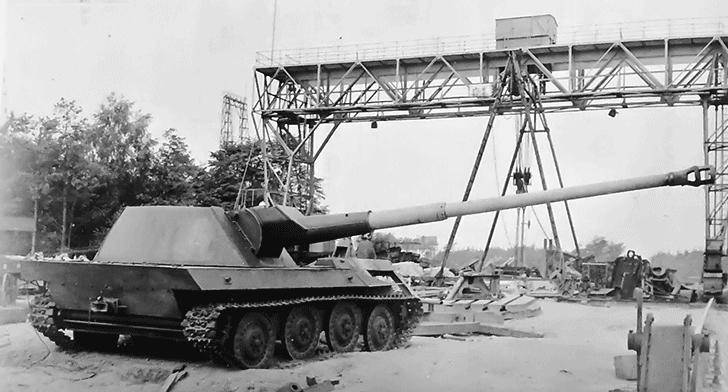
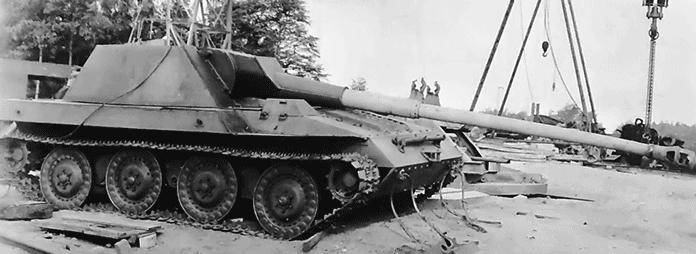
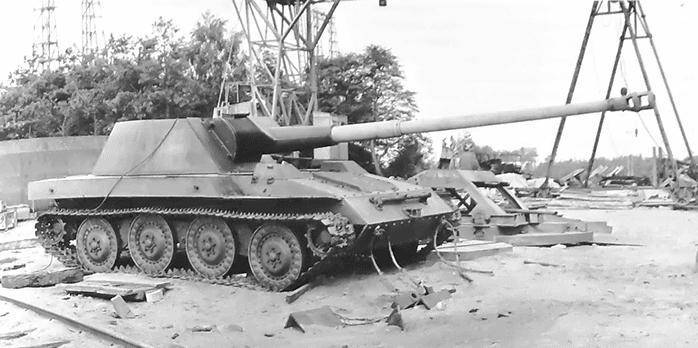
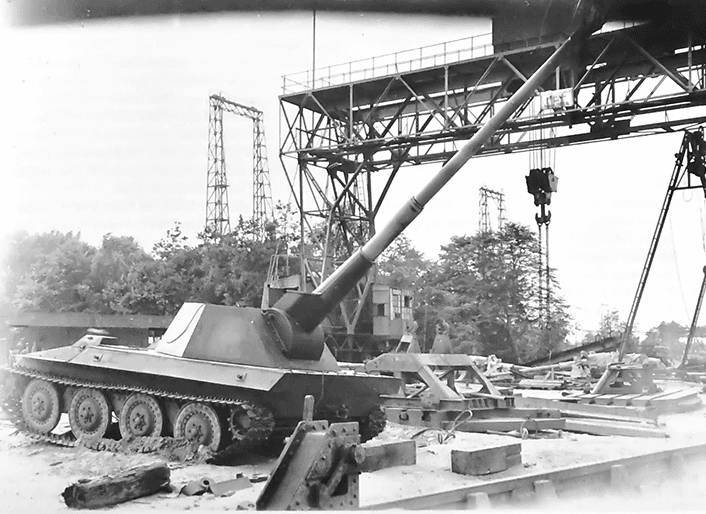
Prototype Waffentrager by Steyr-Daimler-Puch. Spring 1945 of the year
The development of this class of machines began in Germany at the end of 1942. It was supposed to design two versions of “vafcentrugerov”: the first one, on which it was planned to install X / NUMX-mm L / 75 gun, 70-mm howitzer FH 105 or 18-mm Flak 37 anti-aircraft gun, and the second, heavier, for 18-mm Gun 88 anti-aircraft gun, 43-mm howitzer FH 150 or 43-mm cannon K 128.
It was assumed that a single undercarriage of a special design would be developed for the “waffering gears”, and it was intended to use one of the engines that were in mass production and ensure the vehicle’s march speed not lower than 17 km / h. The gun was supposed to have horizontal shelling in 360 degrees, as well as easily removed from the chassis by the crew and rearranged to the usual field gun carriage.
Krupp, Rheinmetall-Borsig and Steyr-Daimler-Puch firms were involved in the creation of "waffentragers". But the first projects submitted to the Artillery Armaments Test Department (WaPruf 4) of the Army Armaments Directorate at the end of 1943 of the year did not receive approval - it was clear that the developed machines were too complex and heavy.
After reviewing the tactical and technical requirements and clarifying a number of parameters of the "waffentragers", from 7 to 15 in February 1944, a meeting of representatives of the tank and artillery weapon test departments was held, at which various versions of these machines were proposed by Krupp, Steyr and Rheinmetall.
Krupp presented three different “waffentragus” projects (with 88 X-guns 43) developed by three design bureaus: the Welfert group, the Egen group and the Burger group. In addition, the meeting addressed the issue of the “waffen-trager” for the 105-mm howitzer FH 18 / 40, the project of which was also proposed by Krupp. This installation envisaged the use of the 38 (t) tank chassis with detachable howitzer installation. The latter had a small height of the line of fire and was mounted in a rotary armored wheelhouse, providing circular fire. This project also took into account the possible use of 75-mm KwK 42 guns.
Second Ardelt design Waffentrager prototype with 88-mm RaN 43 cannon
24 February 1944 in the test section of artillery weapons (WaPruf 4) in Berlin heard the results of the preliminary design of the "wafftnergers" and their coordination with the previously put forward tactical and technical requirements.
It was decided first of all to use the 88-mm Cannon 43 L / 71 Cannon with its main components for arming these machines. It was supposed to redesign the trunk mount stopper in a marching way, the horizontal guidance mechanism and the armor protection of the calculation. In addition, the task was set to simplify and cheapen the construction of “waffentragers” as far as possible. For example, in projects of the Krupp company for the transportation of parts of the field gun carriage, lifting and loading and supporting devices, as well as most of the ammunition, a special conveyor was used.
Along with this, the tank armament tests department (WaPruf 6) insisted on using, in the design of the "waffer-hanger" already existing in production and tested in operation units and assemblies of tanks or tractors. First of all, it was about the chassis of the Jagdpanzer 38 and the Praga engine with a capacity of 160 l. with. It was also supposed to study the possibility of using for the “vaffentragers” the 8-cylinder diesel engine Klockner-Humboldt-Deitz, which was currently undergoing tests, with the 140 hp, as well as the gearbox and the rotation mechanism with heavy tractors from Bussing-NAG.
A report from 4 of May 1944 of the year indicated that the assembly of the first samples of the “waffentragers” of Rheinmetall and Steyr-Daimler-Puch was being delayed. However, by the end of the summer the car was able to assemble.
Steyr's Vaffentger was equipped with the new Steyr-Boxer 12-carburetor engine, and also had a gearbox, running gear elements and tracks from the RSO tractor. The machine was armed with a 88-mm anti-tank gun PAK 43 in a six-sided circular armored wheelhouse. At the same time, the elevation angles ranged from -8 to + 45 degrees, portable ammunition - 15 shots. The car was defended with 10 — 20 mm thick armor, and reached speeds of up to 35 km / h on the highway.
The Vhafftunger of the Rheinmetall company was structurally similar to the Shteier-sky, but differed from it by using the chassis of the Jagdpanzer 38 self-propelled gun (t) and the Praga engine.
However, the most successful way "Waf-Fratergera" military recognized the car, designed by Ardeltwerke in the city of Eberswalde. Its development was led by G. Ardelt, the owner of the company. Unfortunately, little is known about him.
For example, the famous German armored researcher V. Spielberger wrote that being on the Soviet-German front, Ardelt witnessed how 70 new 88-mm guns of the 43 Cancer were thrown and got to the enemy due to the lack of artillery tractors. At the end of 1943, he designed a self-propelled gun by installing the engine on a 75-mm RaN 40 cannon. This system passed the test at the ground of the ground forces in Kummersdorf, but was declared unsuccessful.
At the end of 1943, the artillery armament test department (WaPruf 4) entered into an agreement with Ardelt for the design and manufacturing of an “wuffentra-gera” at the Ardeltwerke, which was easily suited for installing the 105-mm howitzer, 75-mm KwK42hNNXX-mm XK gun.
At the beginning of 1944, Ardel presented to the “Tank Development Commission” a draft of his vehicle, armed with an 88-mm RaN 43 cannon. The development was approved, and 17 on April 1944, the artillery weapons testing department asked Krupp engineers to help Ardel’s firm in further developing the waffentrager and manufacturing the prototype. Therefore, in some sources, this machine is called "Arffelt Vuffcentuer - Krupp."
The prototype machine, sometimes called the "Waffenturger Ardelt I," was quickly assembled - within a month. 30 May 1944 self-propelled guns demonstrated to the military at the site in Kummersdorf. The gun was fairly simple - it had a chassis and an engine from the Hetzer, and the armament (88-mm Cannon 43) was mounted on a pedestal in the stern of the vehicle. The gun had a circular fire and defended by an armored shield in front and partly from the sides.
I liked the car very much, and right there it was decided to manufacture a so-called “zero” series of 100 units for front-line tests, with 82-mm guns being armed with them, and 88 was supposed to be assembled as ammunition transporters. The assembly was to be carried out by Ardeltwerke, a number of parts were supposed to be supplied from the factories of other companies. In parallel with this, a second copy of the “waffentragger” was being made, in the design of which a number of changes were made. In the summer of 12, this machine was successfully tested by mileage and shooting at the ground in Hillersleben.
In August, 1944, the prototypes of "waffentragers" were demonstrated to Hitler. Of all of them, the Ardelta car was the easiest and cheapest. However, this model met the necessary requirements for mobility and tactical use, and was also very simple in design.
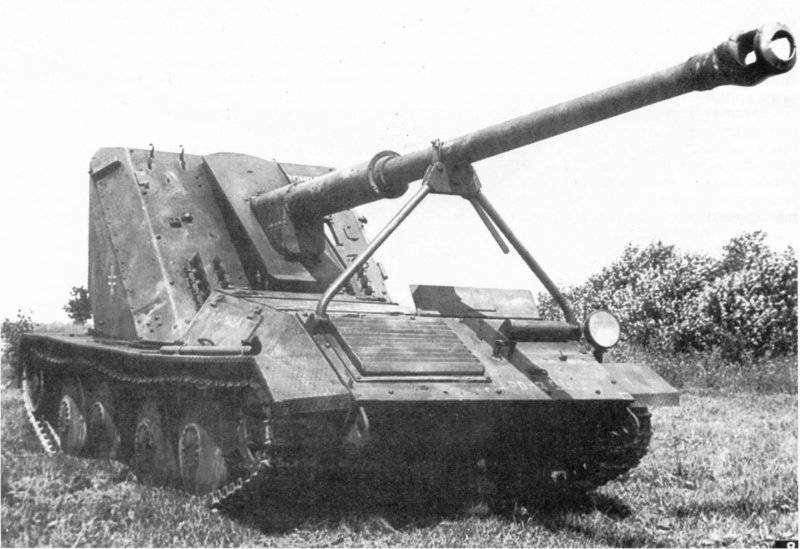
General view of the production model of the “waffentrager” Ardelt, who arrived for testing in Kubinka near Moscow. Spring 1946 of the Year (CMVS)
However, the production of machines "zero" series was inhibited. So, July 31 1944, the artillery weapons testing department reported the following release schedule: 34 in August, and 33 in September and October. However, nothing was done, and on October 6 it was reported that the first 20 "waffentragers" would be assembled before the end of the month.
At a meeting on the manufacture of these self-propelled guns, held in Berlin 12 December 1944 of the year, it was reported that the first 10 “waffentragers” will be assembled before the end of the month, and 10 - before January 15 1945. In addition, work was almost completed on the manufacture and delivery of parts for the assembly of the remaining 80 machines.
However, on 9 January 1945, two cars were assembled, and 18 were still semi-finished and were not equipped with undercarriage elements.
How much of all was made by Ardelt's “waffentergers”, the author is unknown. All that can be said for certain is that 16 February 1945, the headquarters of the Army Group Vistula, sent the following to the head of Ardelt in Eberswald:
Thus, it is possible to speak of no less than seven assembled serial “waffen-tragers” of Ardelta. In addition, it is known that one serial sample of the machine was used at the 27 April 1945 test site in Hillersleben. At least two of these self-propelled guns were captured in the spring of 1945 by units of General A. Gorbatov’s 3 Army (1 of the Belorussian Front): one in the Vandish-Buchholz area (south-east of Berlin), the other in Brandenburg, south-west of Berlin. One such machine (perhaps from among the two captured) in the summer of 1945, was at an exhibition of captured weapons and equipment in the Gorky Park of Culture and Rest in Moscow. On board the car was the inscription: "From Berlin." According to the German researcher V. Spielberger, “Robert Ardelt” himself “died in one of his“ waffentragers ”defending his hometown of Eberswalde”.
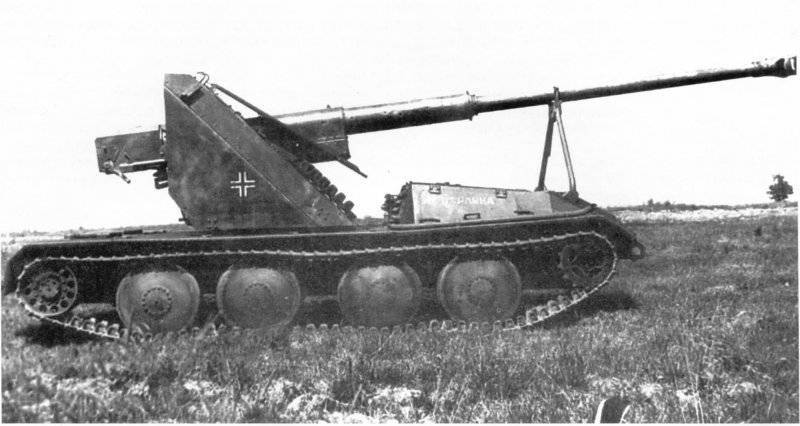
A serial sample of the waffentrager Ardelta, who arrived in Kubinka near Moscow for testing. Spring 1946 of the year. On the right side of the hull the inscription "From Berlin" (CMVS) is visible.
It should be said that at the beginning of 1945, the Army Armaments Directorate decided to deploy mass production of “waffentragers”. For the organization of production, a working group was created under the leadership of the Oberinener Kracht from the company Auto-Union, which also included representatives of the firms Krupp and Ardelt. The production volume was set as follows: March - 5 machines, April - 15, May - 30, June - 50, July - 80, August - 120, September - 170, October - 250, November - 300, and starting from December to 350 units month.
At the same time, in addition to Ardelt’s “waffentergers” with 88-mm guns, it was supposed to launch similar machines into production, but with more powerful artillery systems. At the end of 1944, Krupp designed several models armed with 105 and 150-mm howitzers, as well as an 128-mm anti-tank gun. In their design, the already worked-out elements of the “vaffcentruger” Ardelta were used, but with a reinforced undercarriage (six support rollers per side). According to the scheme of placement of weapons (in the stern of the machine behind the sewing), they also resembled the design of Ardelta. In the future, it was planned to use elements from Jagdpanzer 38 D in the construction of these self-propelled guns - the undercarriage elements and the Tatra 103 diesel engine. However, until the end of the war to complete the design failed.
Thus, it can be said that the “waffer-tragers” could well have replaced the self-propelled guns on the battlefield with tank chassis with 88, 105, 128 and 150 mm guns. And the machines with 88-mm anti-tank guns in the last months of the war were already in production.
It is interesting to cite data on the Ardelta “waffenterer” device as well as data on its testing in the Soviet Union, conducted in the spring of 1946.
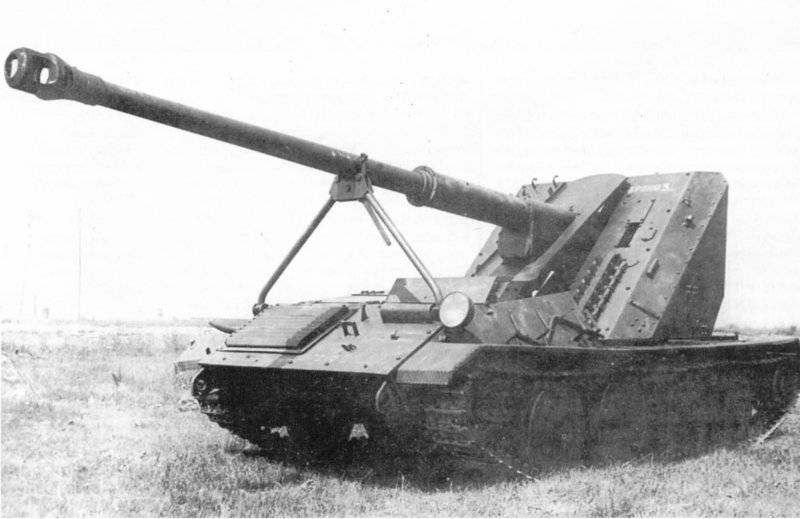
Serdel vaffentraguera model, left view. NIBT polygon, spring 1946 of the year. On the shield and the case are visible inscriptions indicating the thickness of the armor (CMVS)
Machine device
The body of the self-propelled gun was quite simple in design and was made of sheets of rolled armor with a thickness of 8-20 mm, connected by rivets and welding. He could withstand hits from simple (not armor-piercing) bullets of normal caliber and small fragments. Armament consisted of 88-mm anti-tank gun RAC 43, mounted on a stand installation in the rear of the hull. The bollard was attached to a special beam U-shaped profile installed across the body. The gun had a regular upper machine, lifting and turning mechanisms, sighting devices and a trigger device. The gun had a circular fire on the horizon. The front, and partly from the sides, the calculation was covered by an armor shield with a thickness of 5 mm. In the stowed position, the trunk was fixed with the help of a special scissor support fixed on the front sheet of the hull. The striker was placed in three places - in a box reinforced on the inside of the shield (6 shells) and in two boxes (12 shells) in the stern of the hull.
The power plant consisted of a Maybach HL-42 carburetor four-stroke six-cylinder engine installed in the front of the hull on the right (such 100 HP engines were used on the German Sd. Kfz. 250 and 251 armored personnel carriers). Engine cooling is liquid, the coolant is circulated by a centrifugal pump. The engine's power supply system consisted of a fuel-priming pump, a Solex carburetor, an intake manifold, an air cleaner and two 60 l fuel tanks located to the right and to the left of the implement rig.
Transmission "Vaffratergera" included an intermediate gear (guitar), main friction clutch, gearbox, steering mechanism and final drives. The main clutch is dry, multidisk, automobile. The gearbox is a car, four-speed, with a mechanical gear shift, four forward and one back. The rotation mechanism is a double differential, equipped with additional stopping brakes driven by a special pedal.
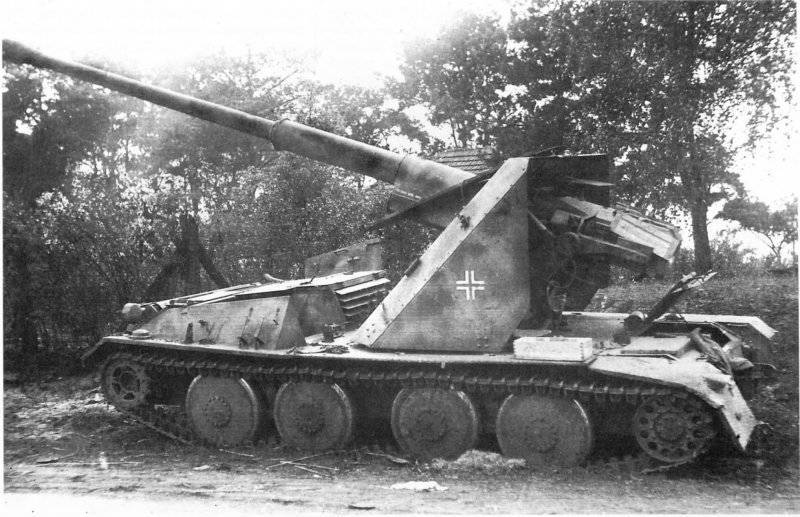
“Waffenturger” Ardelta, captured by Red Army units in the Vandish-Buchholz area (southeast of Berlin). April 1945 of the Year (ASKM)
The turn of the self-propelled gun was carried out under the control of the corresponding brake drum, while one caterpillar could not be completely slowed down, as a result of which the machine could not be turned in place. The onboard transmission was a single-stage gearbox with spur gears.
In the chassis used all-metal track rollers, structurally similar to the rollers self-propelled "Hetzer", but without rubber tires. Suspension and tracks were used "Hetzer".
The electrical equipment was made using a single-wire circuit and consisted of a generator with a relay regulator, one battery (installed in a special box behind the back of the driver's seat), an electric starter and a road headlight.
The crew of the car consisted of four people. The driver was located in front of the case on the left side of the car seat. The machine was controlled by levers and three pedals, the efforts of which were 20 — 25 and 15 — 20 kg, respectively. Control over the work of the units was carried out using only three devices - a tachometer, an oil pressure gauge and an aerothermometer of the fluid in the cooling system. Observing the road in the stowed position was carried out by the driver-mechanic directly from the front of the hull, and in the fighting position — through the observation slot in the folding armor shield. Heating, lighting and ventilation of the driver’s seat were absent.
The gunner was located to the left of the gun, at the sight and guidance mechanisms, on a special seat that rotated with the machine tool. The commander and loader were placed on the seats in the back of the car. When firing, the commander was near the car and corrected the fire. The Waffenturger was equipped with an intercom between the driver and the commander.
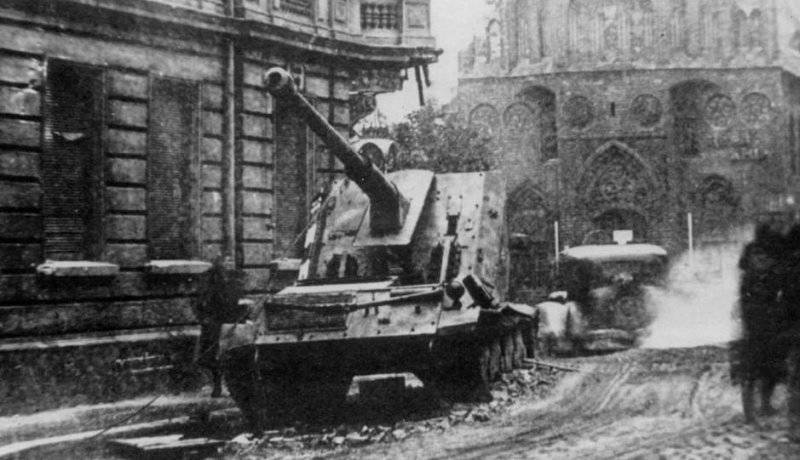
The serial variant of the “waffentrager” Ardelta, left on the street of the city of Brandenburg. May 1945 of the year (ASKM)
It should be noted that shooting from the course was impossible due to the lack of a fence for the calculation. At the same time, there were excellent conditions for firing from the spot, because of the low line of fire it was possible to load the gun, even while on the ground.
Testing machine
In the spring of 1946 of the year, the waffenturger, who had previously been at the exhibition of captured equipment, was taken to the training ground in Kubinka near Moscow. In our documents, it was called "an open German self-propelled unit with a 88-mm RaN 43 cannon." Due to the “insufficient reliability of the self-propelled unit, due to a constructive and technological flaw, as well as an unsatisfactory technical condition,” it was not possible to carry out tests in full. In total, the car passed 200 kilometers, and 56 shots were made from the gun. Moreover, due to the lack of a regular German sight, the shooting was carried out with the help of a Japanese telescopic sight mounted on the aiming device using a specially made bracket. It is interesting to bring conclusions made in the report by our testers. Apparently, they did not know to which class this car was attributed - it was light in weight, and in terms of armament it corresponded to medium or heavy self-propelled guns:
When creating it were used:
- 88-mm anti-tank gun RAC-43, previously installed on the ACS "Hornisse";
- HL-42 engine, main clutch, gearbox, turning mechanism and final drives from German light semi-tracked tractor;
- tracks from the tank "Prague" 38-T.
This unification of the majority of the main units indicates a desire to reduce the cost and mass production of a new type of self-propelled unit.
However, a number of weak installation sites - the engine cooling system, the gearshift mechanism, the lack of protection of the crew from dust, dirt and precipitation, the mounting of the support rollers - indicate a tight time frame for designing, developing and manufacturing the first batch of machines.
The basic idea of the design of the installation - the open placement of an artillery system with circular shelling - completely justified itself. This event was able to provide good working conditions for the crew, which are essentially the same as the conditions for the work of crews of field artillery systems. ”
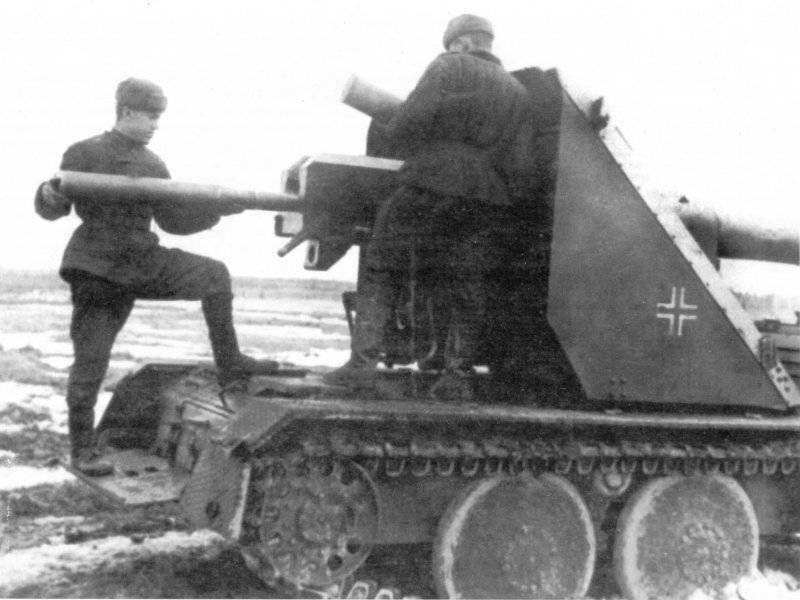
The loading of the gun "vaffsentragera" Ardelta at course angle O degrees. The second calculation number takes shots from the box on the armor shield. The convenience of the first number was achieved by tilting the stern platform, on which the loader's right leg is standing. NIBT polygon, spring 1946 of the year (ASKM)
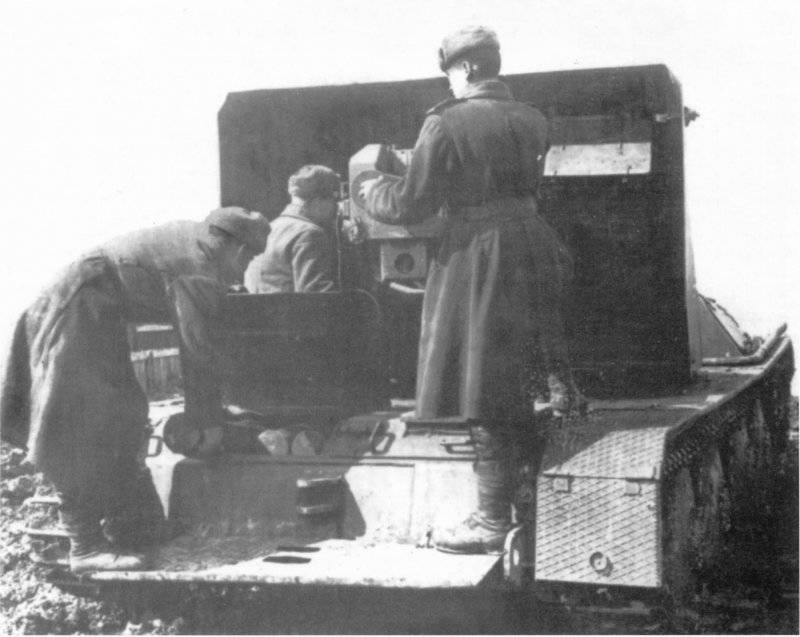
Loading the gun "vaffsentragera" Ardelta at course angle O degrees, rear view. Shots are taken from the right feed box. The loader's left leg is standing on the folded down feeding platform. NIBT polygon, spring 1946 of the year (ASKM)
During the tests, our specialists conducted an assessment of weapons, dynamic and operational performance and crew jobs. In particular, it was noted that the accuracy of the gun battle when shooting from a place (at a distance of 1000 m) is quite satisfactory, the probable deviations in height and direction did not exceed 0,22 m. The rate of fire (when shooting from a place at a fixed target) was 7,4 shot per minute, which also considered a good indicator. It was noted that the hydropneumatic balancing mechanism provides constant effort on the lifting wheel of the flywheel at elevation angles from -8 to + 40 degrees. However, the lifting mechanism provided a low speed of vertical guidance and created great efforts on the handle of the flywheel. The turning mechanism, on the contrary, ensured a sufficient speed of pointing over the horizon and normal forces on the handle of the flywheel. And the removal of the axles of the oscillating part of the gun back relative to the center of the thumbs installation, reduced the magnitude of the trunk ejection, contributed to the balancing of the fire platform and increased the angle of elevation of the gun.
According to the dynamic indicators, a good smoothness of the car, unsatisfactory maneuverability (due to the use of a double differential as a mechanism for turning) and a small power reserve (111 km on an asphalt road and 62 km on a dirt road) were noted.
The assessment of jobs said that finding the commander during shooting outside the car provides him with the convenience of observation. The gunner was placed on the seat to the left of the gun, at the guidance and sight mechanisms, which he was comfortable using. Charging during the shooting could be to the right or left of the gun. The convenience of his work was provided by tilting the feed area. During the movement, the loader and the commander were in the back seats of the platform of fire, which were very uncomfortable - hard and of insufficient size.
The mechanic-driver during the shooting served as a carrier of ammunition. It was noted that the lack of driver's seat was a significant removal of the control pedals from the seat, an insufficient number of control devices and high temperature (up to 70 degrees) due to the ejection of air heated by the engine into the control compartment. A common disadvantage of all jobs when driving was the lack of protection from rain, snow, dust and dirt. The advantages of the car were attributed:
2. Open placement tools, providing good working conditions calculation.
3. Satisfactory stability of the installation achieved by the use of the muzzle brake, a large recoil length and the successful placement of the center of gravity.
4. High maneuverability of fire, provided a roundabout and unitary shot.
5. Rapid transfer of fire in any sector of fire, achieved by turning the gun when the turning mechanism is off.
6. Quick transition from traveling to combat.
7. Successful stopper guns in marching, securely and simply fixing gun.
8. Compact placement of engine compartment units, achieved by the introduction of an intermediate gear between the engine and the main clutch. "
However, the number of disadvantages exceeded the number of advantages. Among the main ones in the test report were the following:
2. The insecurity of the driver from the blast wave during shelling and the absence of fences for calculation exclude firing from the course and short stops.
3. Correction of fire by the gunner through the sight and through the hatch of the armor shield is impossible due to the closing of the target and the tracer with the powder gases.
4. Lack of easily removable awning over the fire platform and protective cap over the control compartment. As a result, the crew is completely unprotected from dust, dirt and precipitation.
5. A flaw in the engine cooling system, which is as follows: there is no tensioning device for the drive belt to the fan, the formation of counter-currents of air heated by the engine and ejected by the fan through the louvers in the front sheet and the outside (especially with a head wind) entering through the louver in the engine compartment.
6. Insufficient reliability of the gearshift mechanism.
7. Unreliable fastening of the suspension roller covers.
8. Significant removal of the pedals from the driver’s seat.
9. Unsuccessful seat design fire platform.
10. Departure in front of the tracks of the towing loops, as a result of which the height of the overcoming vertical obstacle is limited.
11. Insufficient transportable stock of shells. ”
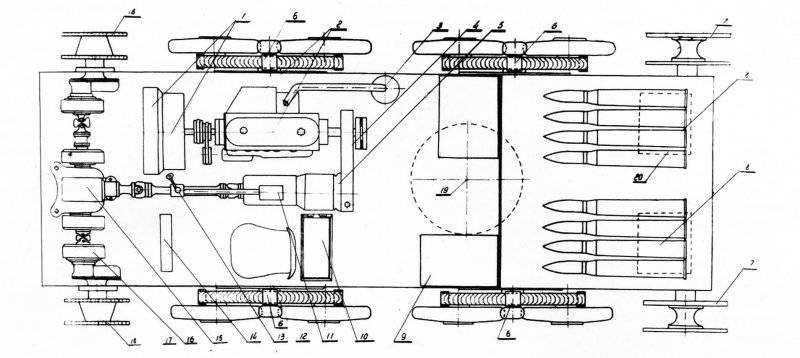
Ardelt's vaffentrager layout: 1 - fan and radiator, 2 - engine, 3 - air cleaner, 4 - intermediate gearbox, 5 - main friction clutch, 6 - suspension unit, 7 - steering wheel, 8 - boyukladka, 9 - suspension unit, 10 - steering wheel, 11 - intermediate suspension reducer 12 - battery, 13 - gearbox, 14- driver's seat, 15 - gearbox rocker, 16- instrument panel, 17 - double differential, 18 - stopping brake, 19- onboard gear, 20- drive wheel, XNUMX- axis pedestal installation, XNUMX - seat calculation
In the conclusion of the test report on the “waffenterger” Ardelt, the following was said:
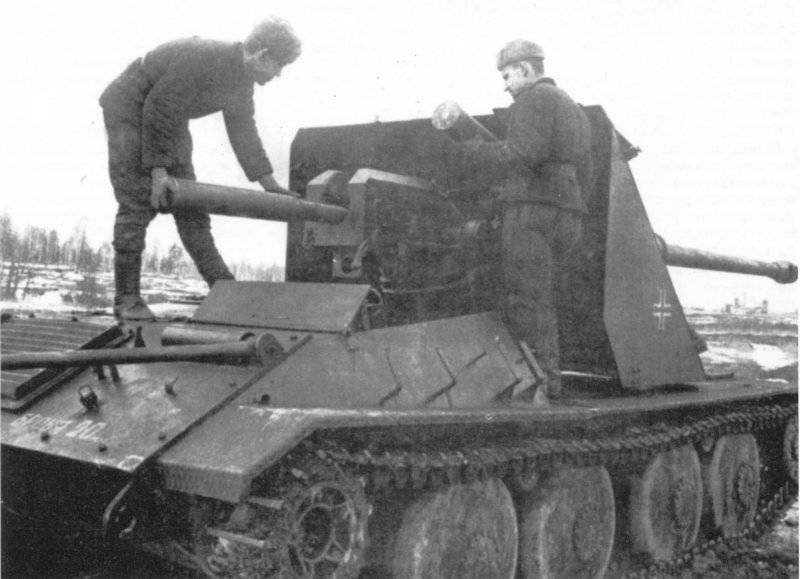
Loading the gun "vaffcentraera" Ardelta at course angle 180 degrees. The first number is located on an extra-engine roof, shots are taken from laying on the armor shield of the gun. Spring 1946 of the year (ASKM)
Along with this, a number of design flaws and lack of reliability indicate that the development and creation of the machine were not completed and probably were carried out in a short time.
It is also necessary to note the compact placement of the units of the engine-transmission compartment. This was achieved by introducing an intermediate gear (guitar) between the engine and gearbox, which allowed them to avoid their usual co-axial arrangement.
It is noteworthy to ensure free access to the ammunition and gun when loading due to the lack of sides, stern and roof at the firing platform, the availability of a folding stern platform and placing ammunition in places convenient for getting.
The most characteristic feature of the tested self-propelled installation in terms of weight is that the installation of weapons and ammunition accounts for up to 30% of the total weight. The power of the shot tested SAU far out of the class of light (by weight) and is equivalent to medium and heavy self-propelled guns.
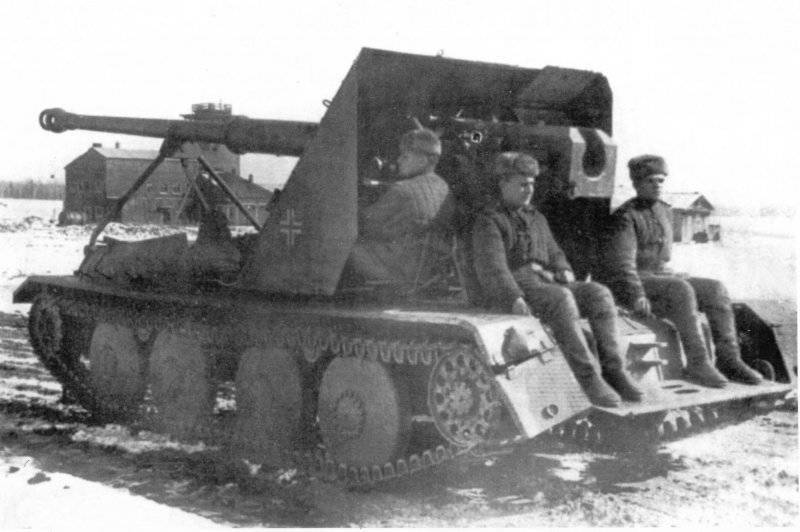
Accommodation crew "vaffentrager" Ardelta on the march. NIBT polygon, spring 1946 of the year (ASKM)
At the same time, this machine in terms of the power density of the shot (the ratio of the power of the shot to the combat weight) significantly exceeds all the cars known so far.
In general, this self-propelled unit has a number of significant drawbacks due to structural flaws and therefore cannot be used as a model for creating a domestic unit of this type. The following data are of practical interest in this ACS: the overall layout of the vehicle and the idea of combining powerful weapons and a light base of a special type.
The basis for the design of a prototype of a domestic open-source self-propelled guns (tank destroyer) should be a 100 mm caliber gun with an initial speed of 1000 m / s, mounted on a special base created from T-44 or T-54 tank units. "
The sample of the “waffentragger” of the Ardelt design, which was tested, has survived to the present day, and is currently on display at the military history museum of armored weapons and equipment in Kubinka, near Moscow.
- Maxim Kolomiets, "Hitler's last tanks"
- German tank industry to 1945 year
Infrared devices for German tanks
Modernization of the "Royal Tiger", 1945 year
Tanks "Panther" in 1945 year
"Waffentragers"
Jagdpanzer 38D tank destroyer
German anti-aircraft tanks
Small tank destroyers of Germany
E series tanks
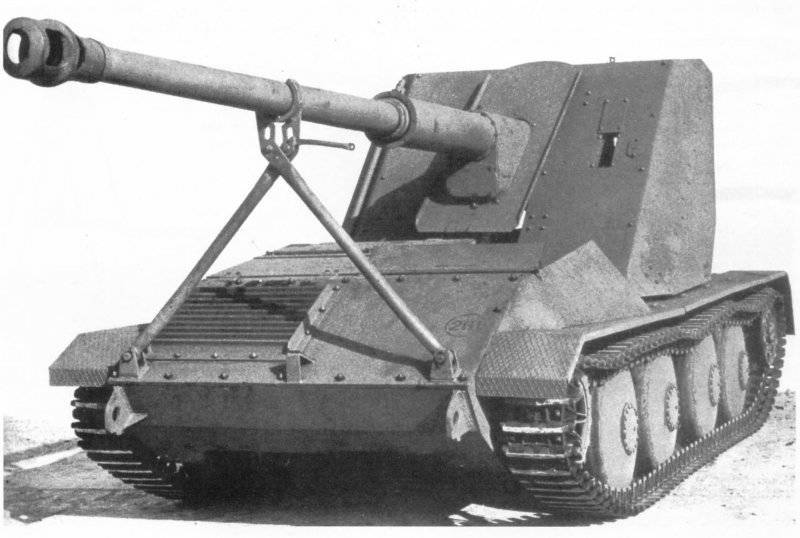
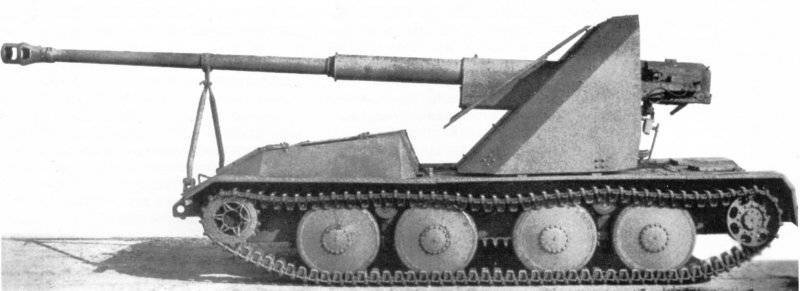
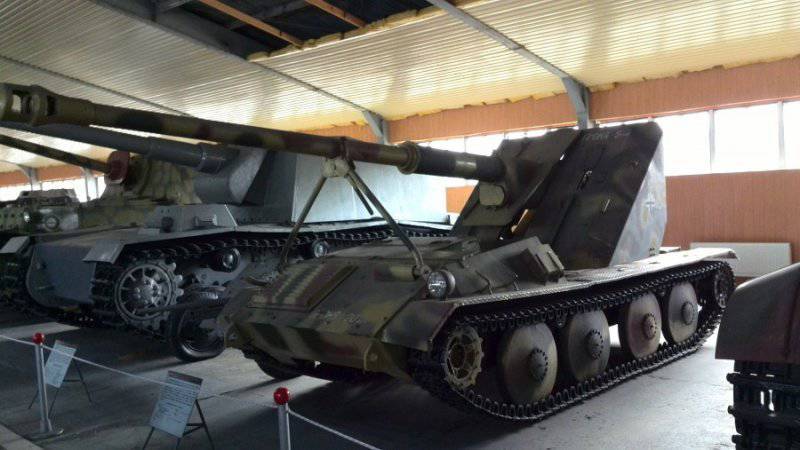
Information